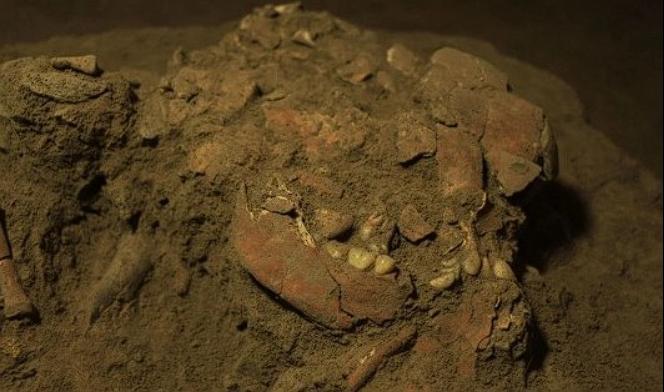“The discovery of a 7,200-year-old burial in the depths of Leang Panninge cave, nestled within the humid heart of Sulawesi, Indonesia, has fundamentally altered our understanding of early human migration and interaction in the Wallacea region. The remains of a young woman, preserved against the odds of tropical decay, offered a direct link to the enigmatic Toalean culture, a hunter-gatherer society that once thrived in Sulawesi’s southwestern peninsula. However, it was her ancient DNA that provided the most profound revelations, rewriting the narrative of human expansion into Oceania.”
A Glimpse into the Toalean World: Unearthing the Past
- The Cave’s Secret:
- Leang Panninge cave, a site of archaeological significance, held within its depths the burial of a young woman who lived millennia ago. The preservation of her skeletal remains, an anomaly in the humid climate, provided a rare opportunity to study a people whose existence was largely shrouded in mystery.
- The Toalean culture, to which she belonged, represented a hunter-gatherer society that inhabited Sulawesi between 8,000 and 1,500 years ago. Their way of life, adapted to the unique environment of the island, remains a subject of ongoing research.
- Genetic Revelations:
- The extraction of DNA from the woman’s inner ear bones yielded astonishing results. Her genetic profile revealed a close relationship to contemporary Aboriginal Australians and Melanesians, descendants of the earliest humans to venture into Oceania.
- This genetic link provided tangible evidence of the ancient migrations that shaped the demographic landscape of the region, connecting the Toalean people to the broader story of human expansion.
- Denisovan Echoes:
- Perhaps the most startling discovery was the presence of Denisovan DNA within her genome. This archaic hominin, whose presence in Wallacea had long been debated, left a genetic signature in the Toalean woman, indicating a potential encounter between modern humans and Denisovans in this region.
- This finding challenged previous assumptions about the region’s role in human migration, suggesting that Sulawesi was not merely a stepping stone, but a contact zone where distinct human lineages intersected.
A Contact Zone: Redefining Wallacea’s Role in Human History
- Migration and Interaction:
- The Toalean woman’s DNA provided compelling evidence that Wallacea, the region encompassing Sulawesi, played a crucial role in the interaction between modern humans and Denisovans. This interaction, which may have occurred tens of thousands of years ago, left a lasting genetic legacy.
- The presence of Denisovan DNA in the Toalean genome suggests that these archaic hominins were not confined to Siberia and East Asia, as previously thought, but also inhabited or interacted with populations in Southeast Asia.
- Early Oceanic Crossings:
- The genetic link between the Toalean people and Aboriginal Australians and Melanesians highlights the early maritime capabilities of humans in this region. These early oceanic crossings, potentially dating back as far as 65,000 years ago, shaped the settlement of Australia and surrounding islands.
- The Toalean woman’s DNA provides a window into these ancient voyages, shedding light on the complex migratory patterns that led to the peopling of Oceania.
- Rewriting the Narrative:
- The discoveries in Leang Panninge cave have prompted a reevaluation of the Wallacea region’s role in human history. It is no longer seen as a mere transit point, but as a dynamic contact zone where diverse human lineages met, interacted, and left behind genetic echoes.
- This new understanding challenges established narratives of human migration, emphasizing the complexity and interconnectedness of early human populations.
A Lost Chapter Remembered: Implications and Future Research
- The Woman’s Story:
- The young woman whose remains were unearthed in Leang Panninge cave, who died at the age of 18, serves as a poignant reminder of the human stories that lie buried in the past. Her life, though brief, provides a glimpse into a vanished world and a pivotal moment in human history.
- Her DNA, extracted from her delicate inner ear bones, tells a story of ancient migrations, intermingling lineages, and early oceanic crossings.
- Unraveling the Past:
- The research conducted on the Toalean woman’s remains has opened new avenues for understanding the complex history of human migration and interaction in Wallacea. Future studies will focus on further analyzing her DNA and exploring other archaeological sites in the region.
- These investigations aim to shed light on the cultural practices, adaptations, and genetic diversity of the Toalean people and their relationship to other early human populations.
- A Broader Human Story:
- The findings in Leang Panninge cave contribute to a broader understanding of human evolution and migration. They highlight the interconnectedness of human populations across continents and the importance of interdisciplinary research in unraveling the past.
- This discovery shows that the human story is far more complex and fascinating than previously imagined, and there are still many lost chapters waiting to be rediscovered.
Conclusion:
“The 7,200-year-old Toalean woman, unearthed from the depths of Leang Panninge cave, has provided a profound insight into a lost chapter of human history. Her DNA, a testament to ancient migrations and intermingling lineages, has rewritten the narrative of human expansion into Oceania, transforming our understanding of the Wallacea region. Her story, a poignant reminder of the human journey, continues to inspire research and deepen our understanding of our shared past.”

CÁC TIN KHÁC
Mary Walton: The Forgotten Inventor Who Helped Clean Up America’s Cities
Tomb of Queen Nefertari in the Valley of the Queens, Egypt
Discover the Hypostyle Hall of the Temple of Hathor at Dendera
Venus de Losange: Unveiling the Mystery of a 20,000-Year-Old Paleolithic Icon